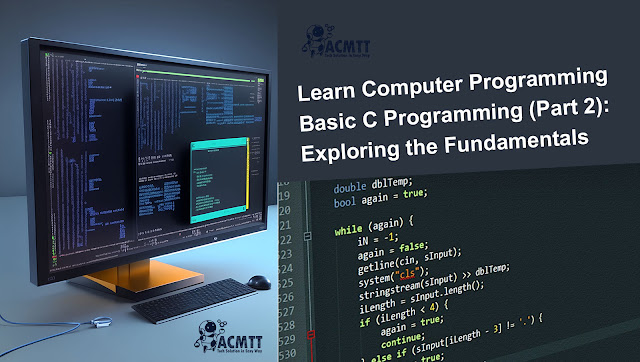Basic C Programming (Part 2): Exploring the Fundamentals - delve into the realm of C programming and explore how to get started. Popular Programming
Introduction to Programming Languages
In our previous lesson, we gained a general understanding of the purpose and process of programming. In this lesson, we will delve into the realm of C programming and explore how to get started. Before that, let's take a brief look at some other programming languages to familiarize ourselves with the concept of programming languages.
Popular Programming Languages:
- Java
- PHP
- JavaScript
- Python
- Objective-C
- Ruby
- Perl
- C, C++, and C#
- SQL
- Swift
Today, we will focus on C programming, a vital language in the world of computer programming. C programming plays a crucial role in enabling computers to make decisions and find solutions. It defines the system by which computer decisions are created through programming.
The Significance of Programming Languages
A programming language serves as a means for computers to understand and execute instructions. Computers, in their most basic form, comprehend only the binary system of 0s and 1s. Imagine having to use these binary instructions for all computer operations—it would be an incredibly complex and arduous task.
To simplify the process, programmers initially relied on assembly language, which introduced metaphoric instructions (e.g., ADD, SUB) instead of solely using 0s and 1s. However, assembly language posed a challenge, as it required in-depth knowledge of machine architecture to write programs. This limitation raised the question of accessibility for individuals without extensive machine expertise.
To address this concern, developers gradually introduced higher-level languages such as C, C++, Java, and more. These languages bridged the gap by providing a more user-friendly approach to programming while still requiring a foundational understanding of the underlying machine architecture.
Structure of a C Program
C is classified as a mid-level programming language. A typical C program consists of three main parts:
Each C program comprises one or more functions, with the user-defined function named main() acting as the entry point. Here's an example of a simple C program:
[#include <stdio.h>int main() {// C is a case-sensitive programming languageprintf("Hello, world!");return 0;}]
It is essential to note that the use of main() is case-sensitive, and any deviation from this exact spelling will result in an error. Similarly, errors may occur if semicolons are replaced with commas or omitted altogether in certain program segments.
The printf() function is used to display output within the main() function. As mentioned earlier, the inclusion of a header file is necessary for declaring C programs. The declaration process involves using the #include directive followed by the desired header file.
Getting Started with C Programming
To begin programming in C, you can use any compiler of your choice, such as Turbo C or Code::Blocks. If Code::Blocks is not installed on your computer, you can easily download it from the official website:
[Code::Blocks Downloads ##download##]
Once Code::Blocks is installed, open a new project, and you will be presented with a window similar to the following:
Learn Computer Programming - Basic C Programming (Part 2)
From there, select "Console application" and save the project with a name of your choice. A new window will appear, allowing you to write your program.
Alternatively, you can open a new project from the "File" menu. Now, let's write a simple program:
[#include <stdio.h>int main() {printf("I am a C programmer");return 0;}]
By typing this program and clicking on the green "Build and Run" button, you will see the output "I am a C programmer" displayed on a separate screen.
Congratulations! You have successfully written your first C program. Now, let's explore how to display multiple lines of output. To achieve this, you can use multiple printf() statements:
[#include <stdio.h>int main() {printf("I am a C programmer\n");printf("This is my first program");return 0;}]
With this code, the output will be displayed on two separate lines:
- [message]
- ##code## Output Will be
- I am a C programmer
This is my first program
To display the lines consecutively without a line break, you can use the escape sequence \n at the end of the first line:
[#include <stdio.h>int main() {printf("I am a C programmer\nThis is my first program");return 0;}]
Feel free to experiment with the code to achieve your desired output.
Remember, practice makes perfect. Start by manually typing out the code rather than relying on copy-paste. As we progress through subsequent parts, we will explore more essential concepts of C programming. Although these parts may not provide a comprehensive understanding of programming, they aim to generate interest and serve as a foundation for further learning. If you find programming intriguing, your enthusiasm will drive you to learn more effectively.
Happy programming!












COMMENTS